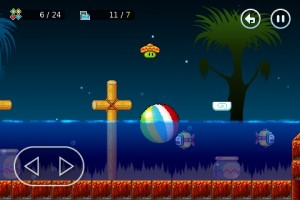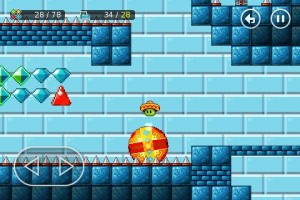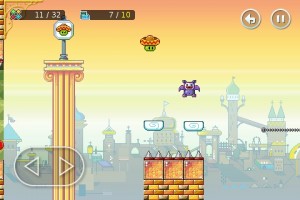I’ll say it again: one of the most interesting things about the iOS gaming industry is the fact that developers are often just getting the ball rolling on release day. Only at some unspecified point months down the road do we discover a game’s full potential in many cases, and so it is with Bean’s Quest Final (Out Now, $2.99; Lite). As the new title implies, this is Kumobius’ debut platformer transformed into a mammoth adventure by its final update, which adds two level sets and introduces a final boss battle that’s one for the history books. Given the particular nature of the App Store I would say it’s hardly fair to compare a game at its most polished to the week-one versions we normally review, hence the subtle difference in article title. That said, the normal review process is well worth going through to highlight all the things Kumobius has gotten right here.
 In case you’re not familiar with Bean’s Quest, it’s essentially a retro platformer with a kind of “Frog Prince” fairytale plot — only this is hardly a typical genre entry because the evil wizard has turned our hero, Emilio, into a Mexican jumping bean. And what’s the first thing we know about Mexican jumping beans? That’s right, they’re always jumping! Imagine playing Mario or Sonic without the hero ever getting a chance to take a breather yet having to deal with all the classic traps and then some, and you’ve got Bean in a nutshell.
In case you’re not familiar with Bean’s Quest, it’s essentially a retro platformer with a kind of “Frog Prince” fairytale plot — only this is hardly a typical genre entry because the evil wizard has turned our hero, Emilio, into a Mexican jumping bean. And what’s the first thing we know about Mexican jumping beans? That’s right, they’re always jumping! Imagine playing Mario or Sonic without the hero ever getting a chance to take a breather yet having to deal with all the classic traps and then some, and you’ve got Bean in a nutshell.
The greatest thing Bean does over the course of its now-50 levels is make the long-time platformer fan learn the ropes all over again. Remember how you were five and you had to gradually develop the sense of timing needed to get Mario over the first few bottomless pits of doom? Bean tests that same learning capacity in novel ways. One of the most basic maneuvers here is launching forward at just the right speed to let Emilio fly through short spiked corridors before he bounces back up and gets skewered on the ceilings. Moving platforms the genre fan once handled with ease are now tricky exercises that demand constant course corrections to follow along. The use-an-enemy-as-a-stepping-stone maneuver, once an advanced tactic, is now a bedrock element of getting Emilio from Point A to Point B.
 Bean tosses in tons of creative action puzzles once the player has a solid grasp on the basics. One of my favorites is something I’ve taken to calling the “ball-and-spike,” which has the player using Emilio’s momentum to push a ball over a spike pit as a means of safe travel. The most dastardly puzzles ask the player to figure out switch sequences in rooms packed with indestructible enemies. Careful attention to detail reveals branching paths the truly advanced player might want to explore. Adding variety are swimming and flying segments that give the player much-needed breaks from Emilio’s incessant hopping.
Bean tosses in tons of creative action puzzles once the player has a solid grasp on the basics. One of my favorites is something I’ve taken to calling the “ball-and-spike,” which has the player using Emilio’s momentum to push a ball over a spike pit as a means of safe travel. The most dastardly puzzles ask the player to figure out switch sequences in rooms packed with indestructible enemies. Careful attention to detail reveals branching paths the truly advanced player might want to explore. Adding variety are swimming and flying segments that give the player much-needed breaks from Emilio’s incessant hopping.
If I make it sound like this game’s tough, you can bet your bean burrito it is! That’s why I’m so pleased with Kumobius’ handling of checkpoints. They’re always set right before a big challenge so the player seldom has to cover the same ground as many times as it takes to master Emilio’s newest dilemma. Solutions could very well disappear if the player snuffs out too many enemies that have to be exploited for high jumps, but reverting to the latest checkpoint is only one button tap away. Together with a few equally solid control configurations, this leaves Bean accessible to veteran challenge seekers and casual players alike.
 The one respect in which Bean falls short is lack of strong motivation to collect all the gems and rescue Emilio’s pet axolotls. Yes, the evil wizard stole away with those too, and thought it a good idea to tuck them into very hard-to-reach places. Game Center achievements are indeed on tap, but as a console veteran weaned on Chaos Emeralds, I can’t help but feel these things need to feed back into gameplay in a meaningful way. My concern here is blunted by how masterful the level design is even when you factor out all the collectibles. Bean has also done a great job eliminating the limited content that was its most widely cited flaw at release. Players will start getting a taste of what the update has to offer as soon as they hit the second world, which is brand new thanks to some reshuffling. Waiting at the other end of the game is another fresh level set that will instantly trigger nostalgia for the fortresses Dr. Wily, Bowser, and Dr. Robotnik once holed up in. True to the retro platformer spirit, these ultimate levels really bring the experience home by tying together all the challenges the player faced beforehand.
The one respect in which Bean falls short is lack of strong motivation to collect all the gems and rescue Emilio’s pet axolotls. Yes, the evil wizard stole away with those too, and thought it a good idea to tuck them into very hard-to-reach places. Game Center achievements are indeed on tap, but as a console veteran weaned on Chaos Emeralds, I can’t help but feel these things need to feed back into gameplay in a meaningful way. My concern here is blunted by how masterful the level design is even when you factor out all the collectibles. Bean has also done a great job eliminating the limited content that was its most widely cited flaw at release. Players will start getting a taste of what the update has to offer as soon as they hit the second world, which is brand new thanks to some reshuffling. Waiting at the other end of the game is another fresh level set that will instantly trigger nostalgia for the fortresses Dr. Wily, Bowser, and Dr. Robotnik once holed up in. True to the retro platformer spirit, these ultimate levels really bring the experience home by tying together all the challenges the player faced beforehand.
Bean’s pixelated aesthetic and often tile-based environments will leave few surprised, but I will say I’m impressed by the fluidity of Emilio’s bouncing and exploding animations. The real star of Bean’s presentation is a soundtrack by Flashygoodness that perfectly sets the mood for this high desert adventure.
iFanzine Verdict: The retro platformer remastered — almost. This final edition of Bean’s Quest more than earns its moderate price tag with pitch perfect level design, a meaty adventure, and a quirky twist on a well-worn genre. It’s clear the developer’s work is done here, but they can still push more boundaries in future projects by presenting challenge collectibles in a way that most players will deeply care about.


